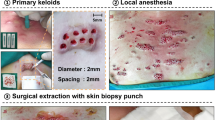Abstract
Keloids are raised reddish nodules that develop at the site of an injury. They are characterized histologically by an abundance of fibroblasts, thick collagen bundles, and ground substance. Auricular keloid formation is a known complication of ear piercing. Many types of treatments have been described for auricular keloids. Pressure therapy in combination with surgery, corticosteroid injection, or both is widely used to manage and prevent hypertrophic scarring. Many pressure devices and procedures have been developed. However, all of them are designed for the earlobe region. If a keloid grows in the posterior auricular region, none of the devices described in the literature will be effective. The authors developed a custom-made silicon ear mold that covers whole ear. With this mold, pressure can be applied homogeneously to the lobule and cartilaginous region, which the other devices described in the literature cannot affect. The preparation technique includes making the negative cast mold of the patient’s ear, creating the positive cast mold from the negative cast mold, and forming the negative silicon mold from the positive cast. After all the processes, a silicon sheet has been designed according to the region needing to be pressurized. The designed silicon sheet is applied to the region, followed by placement of the silicon mold. A simple tennis headband can be used to stabilize the silicon cast. If the keloid extends to the posterior auricular region, pressurizing with clips or other devices described previously will be difficult. Application of pressure to the cartilaginous auricle needs custom-made devices. At this point, a pressure sore caused by a device applied to the ear is the most important problem. To prevent the ear from developing a pressure sore, the device should press to whole area homogeneously. For this reason, the device applied for pressure therapy to the ear must be custom made.


Similar content being viewed by others
References
Akoz T, Gideroglu K, Akan M (2002) Combination of different techniques for the treatment of earlobe keloids. Aesth Plast Surg 26:184–188
Brent B (1978) The role of pressure therapy in management of earlobe keloids: Preliminary report of a controlled study. Ann Plast Surg 1:579–581
Chowdri NA, Masarat M, Mattoo A, Darzi MA (1999) Keloids and hypertrophic scars: results with intraoperative and serial postoperative corticosteroid injection therapy. Aust N Z J Surg 69:655–659
Ragoowansi R, Cornes PG, Moss AL, Glees JP (2003) Treatment of keloids by surgical excision and immediate postoperative single-fraction radiotherapy. Plast Reconstr Surg 111:1853–1859
Rusciani L, Rossi G, Bono R (1993) Use of cryotherapy in the treatment of keloids. J Dermatol Surg Oncol 19:529–534
Russell R, Horlock N, Gault D (2001) Zimmer splintage: a simple effective treatment for keloids following ear piercing. Br J Plast Surg 54:509–510
Savion Y, Sela M (2008) Prefabricated pressure earring for earlobe keloids. J Prosthet Dent 99:406–407
Stern JC, Lucente FE (1989) Carbon dioxide laser excision of earlobe keloids: a prospective study and critical analysis of existing data. Arch Otolaryngol Head Neck Surg 115:1107–1011
Vachiramon A, Bamber MA (2004) A U-loop pressure clip for earlobe keloid. J Prosthet Dent 92:389–391
Author information
Authors and Affiliations
Corresponding author
Rights and permissions
About this article
Cite this article
Yigit, B., Yazar, M., Alyanak, A. et al. A Custom-Made Silicon Mold for Pressure Therapy to Ear Keloids. Aesth Plast Surg 33, 849–851 (2009). https://doi.org/10.1007/s00266-009-9326-z
Received:
Accepted:
Published:
Issue Date:
DOI: https://doi.org/10.1007/s00266-009-9326-z




